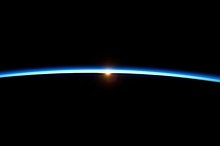|
|
| |
|
|
| |
|
|
|
|
| |
 |
| NASA photo showing
Earth's atmosphere at sunset, with Earth
silhouetted. |
Exosphere
The exosphere (Ancient Greek: ἔξω éxō "outside,
external, beyond", Ancient Greek: σφαῖρα sphaĩra
"sphere") is a thin, atmosphere-like volume surrounding
a planet or natural satellite where molecules are
gravitationally bound to that body, but where the
density is too low for them to behave as a gas by
colliding with each other. In the case of bodies with
substantial atmospheres, such as Earth's atmosphere, the
exosphere is the uppermost layer, where the atmosphere
thins out and merges with interplanetary space. It is
located directly above the thermosphere. Very little is
known about it due to lack of research. Mercury, the
Moon and three Galilean satellites of Jupiter have
surface boundary exospheres, which are exospheres
without a denser atmosphere underneath. The Earth's
exosphere is mostly hydrogen and helium, with some
heavier atoms and molecules near the base. |
|
Earth's exosphere
The most common molecules within Earth's exosphere are
those of the lightest atmospheric gases. Hydrogen is
present throughout the exosphere, with some helium,
carbon dioxide, and atomic oxygen near its base. Because
it can be hard to define the boundary between the
exosphere and outer space, the exosphere may be
considered a part of interplanetary or outer space.
Lower boundary
The lower boundary of the exosphere is called the
exobase. It is also called the 'critical altitude' as
this is the altitude where barometric conditions no
longer apply. Atmospheric temperature becomes nearly a
constant above this altitude. On Earth, the altitude of
the exobase ranges from about 500 to 1,000 kilometres
(310 to 620 mi) depending on solar activity.
The fluctuation in the height of the exobase is
important because this provides atmospheric drag on
satellites, eventually causing them to fall from orbit
if no action is taken to maintain the orbit. |
|
Upper boundary of Earth
In principle, the exosphere covers distances where
particles are still gravitationally bound to Earth, i.e.
particles still have ballistic orbits that will take
them back towards Earth. The upper boundary of the
exosphere can be defined as the distance at which the
influence of solar radiation pressure on atomic hydrogen
exceeds that of Earth's gravitational pull. This happens
at half the distance to the Moon [the average distance
between Earth and the Moon is 384,400 kilometres
(238,900 mi)]. The exosphere, observable from space as
the geocorona, is seen to extend to at least 10,000
kilometres (6,200 mi) from Earth's surface. |
|
|
|
|
|
|
|
|
|
|
|
|
|
|
|
|
|
|
Search Fun Easy English |
|
|
|
|
|
|
|
|
|
|
|
|
|
|
|
About
Contact
Copyright
Resources
Site Map |